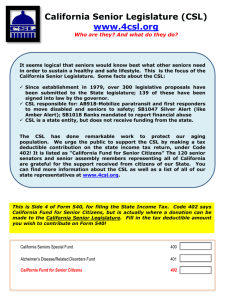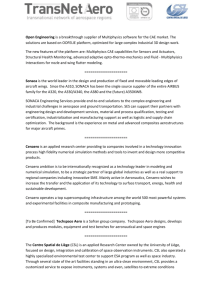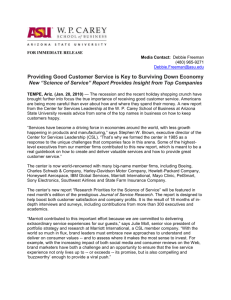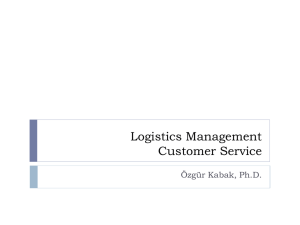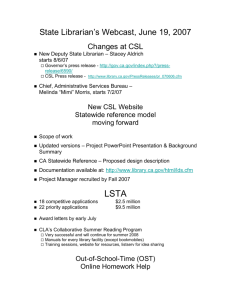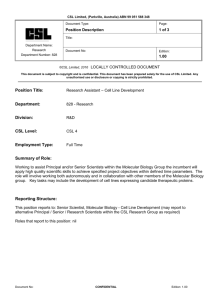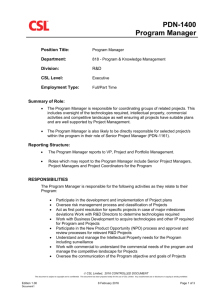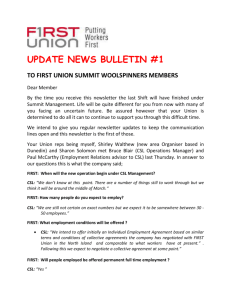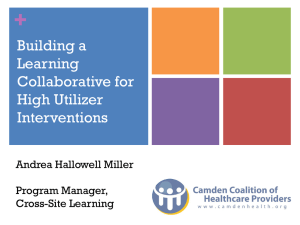Supply Chain Drivers and Obstacles
advertisement
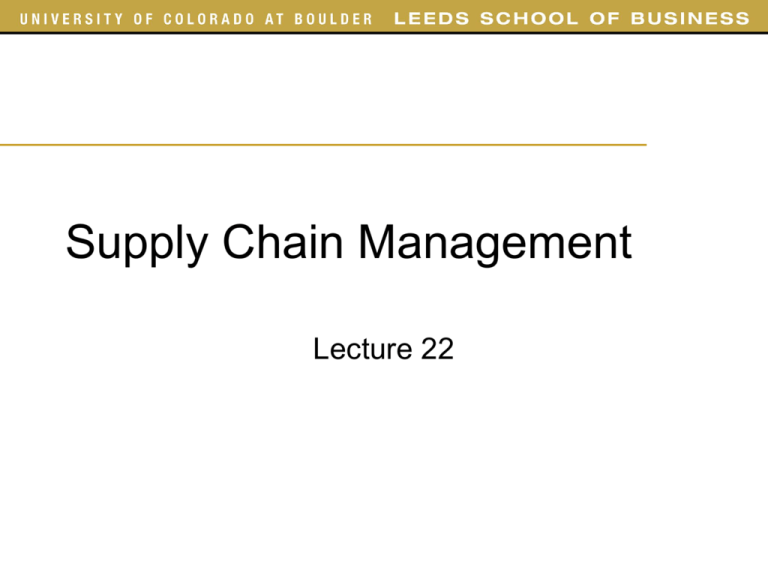
Supply Chain Management Lecture 22 Outline • Today – Finish Chapter 12 • Sections 1, 2, 3 – Section 2 up to and including Example 12.2 • Thursday – Homework 5 due before class – Start with Chapter 14 • Sections 1, 2, 3, 4, 6, 7, 8, 9 – Section 6 buyback and revenue sharing contracts only • Next week – Guest speaker: Paul Dodge • SVP Supply Chain, ProBuild Guest Lecture • Date – Tuesday April 13 • Speaker – Paul Dodge (Senior Vice President – Supply Chain) • Subject – Today’s Supply Chain Semester Outline • • • • • • • • Tuesday April 6 Thursday April 8 Tuesday April 13 Thursday April 15 Tuesday April 20 Thursday April 22 Tuesday April 27 Thursday April 29 Chap 12 Chap 14 Paul Dodge guest lecture Chap 14, 15 Chap 15 Simulation Game briefing Review, buffer Simulation Game The Newsboy/Newsvendor Problem The Newsboy/Newsvendor Problem • Order quantity (O) • Uncertain demand (D) • Cost of overstocking (Co = c – s) – The loss incurred by a firm for each unsold unit at the end of the selling season • Cost of understocking (Cu = p – c) – The margin lost by a firm for each lost sale because there is no inventory on hand • Includes the margin lost from current as well as future sales if the customer does not return O’Neill PsychoFreak 3347 • The “too much/too little problem” – Order too much and inventory is left over at the end of the season – Order too little and sales are lost Submit order to Manufacturer Nov Dec Jan Selling seaon Feb Mar Receive order from Manufacturer Apr May Jun Jul Aug Discount leftovers O’Neill PsychoFreak 3347 • Gather economic data – Selling price (p = $180) – Procurement cost (c = $110) – Discount price (s = $90) • Forecast demand – Empirical demand distribution – Normal demand distribution • Order quantity (so as to maximize profits) Example: Parkas at L.L. Bean Demand D_i 400 500 600 700 800 900 1000 1100 1200 1300 1400 1500 1600 1700 Prob p_i 0.01 0.02 0.04 0.08 0.09 0.11 0.16 0.20 0.11 0.10 0.04 0.02 0.01 0.01 What is the expected demand? Expected demand = ∑Dipi = 1,026 parkas Example: Parkas at L.L. Bean Demand D_i 400 500 600 700 800 900 1000 1100 1200 1300 1400 1500 1600 1700 Prob p_i 0.01 0.02 0.04 0.08 0.09 0.11 0.16 0.20 0.11 0.10 0.04 0.02 0.01 0.01 UnderOverstock stock 0 600 0 500 0 400 0 300 0 200 0 100 0 0 100 0 200 0 300 0 400 0 500 0 600 0 700 0 What is the expected overstock? What is the expected understock? Expected understock = ∑Understockipi = 111 parkas Expected overstock = ∑Overstockipi = 85 parkas Example: Parkas at L.L. Bean Demand D_i 400 500 600 700 800 900 1000 1100 1200 1300 1400 1500 1600 1700 Prob p_i 0.01 0.02 0.04 0.08 0.09 0.11 0.16 0.20 0.11 0.10 0.04 0.02 0.01 0.01 Sold Unsold units units 400 600 500 500 600 400 700 300 800 200 900 100 1000 0 1000 0 1000 0 1000 0 1000 0 1000 0 1000 0 1000 0 Profit 19000 25000 31000 37000 43000 49000 55000 55000 55000 55000 55000 55000 55000 55000 Cost c = $45 Price p = $100 Salvage value s = $40 What is the expected profit? Expected profit = ∑Profitipi = $49,900 Example: Parkas at L.L. Bean Demand D_i 400 500 600 700 800 900 1000 1100 1200 1300 1400 1500 1600 1700 Prob p_i 0.01 0.02 0.04 0.08 0.09 0.11 0.16 0.20 0.11 0.10 0.04 0.02 0.01 0.01 CSL 0.01 0.03 0.07 0.15 0.24 0.35 0.51 0.71 0.82 0.92 0.96 0.98 0.99 1.00 1 - CSL 0.99 0.97 0.93 0.85 0.76 0.65 0.49 0.29 0.18 0.08 0.04 0.02 0.01 0.00 1100 1200 1300 1400 1500 1600 1700 Expected Expected Marg. benefit Marg. cost 5500 x 0.49 = 2695 500 x 0.51 = 255 5500 x 0.29 = 1595 500 x 0.71 = 355 5500 x 0.18 = 990 500 x 0.82 = 410 5500 x 0.08 = 440 500 x 0.92 = 460 5500 x 0.04 = 220 500 x 0.96 = 480 5500 x 0.02 = 110 500 x 0.98 = 490 5500 x 0.01 = 55 500 x 0.99 = 495 (1 – CSL)(p – c) CSL(c – s) Expected Marg. profit 2440 1240 580 -20 -260 -380 -440 Cost of understocking p – c = $55 Cost of overstocking c – s = $5 What is the optimal order quantity? Example: Parkas at L.L. Bean Demand D_i 400 500 600 700 800 900 1000 1100 1200 1300 1400 1500 1600 1700 Prob p_i 0.01 0.02 0.04 0.08 0.09 0.11 0.16 0.20 0.11 0.10 0.04 0.02 0.01 0.01 CSL 0.01 0.03 0.07 0.15 0.24 0.35 0.51 0.71 0.82 0.92 0.96 0.98 0.99 1.00 1 - CSL 0.99 0.97 0.93 0.85 0.76 0.65 0.49 0.29 0.18 0.08 0.04 0.02 0.01 0.00 1100 1200 1300 1400 1500 1600 1700 Expected Expected Marg. benefit Marg. cost 5500 x 0.49 = 2695 500 x 0.51 = 255 5500 x 0.29 = 1595 500 x 0.71 = 355 5500 x 0.18 = 990 500 x 0.82 = 410 5500 x 0.08 = 440 500 x 0.92 = 460 5500 x 0.04 = 220 500 x 0.96 = 480 5500 x 0.02 = 110 500 x 0.98 = 490 5500 x 0.01 = 55 500 x 0.99 = 495 (1 – CSL)(p – c) CSL(c – s) Expected Marg. profit 2440 1240 580 -20 -260 -380 -440 What is the safety stock? Safety stock = Order quantity – Expected Demand Optimal Level of Product Availability • Expected marginal contribution of raising the order size from O* to O*+1 (1 – CSL*)(p – c) – CSL*(c – s) CSL* = Prob(Demand O*) = p–c p–s = Cu Cu + Co O* = F-1(CSL*, , ) = NORMINV(CSL*, , ) Example 12-1: Evaluating the optimal service level for seasonal items • The manager at Sportmart, a sporting goods store, has to decide on the number of skis to purchase for the winter season. Based on past demand data and weather forecasts for the year, management has forecast demand to be normally distributed, with a mean 350 and a standard deviation of 100. Each pair of skis costs $100 and retails for $250. Any unsold skis at the end of the season are disposed of for $85. Assume that it costs $5 to hold a pair of skis in inventory for the season. How many skis should the manager order to maximize expected profits? Example 12-1: Evaluating the optimal service level for seasonal items Average demand (mean) Standard deviation of demand (stdev) = = Material cost c= Price p= Salvage value s= Cost of understocking Cu = Cost of overstocking Co = Optimal cycle service level CSL* = Optimal order size O* = 350 100 $100 $250 85 – 5 = $80 p – c = 250 – 100 = $150 c – s = 100 – 80 = $20 Cu/(Cu + Co) = 150/170 = 0.88 NORMINV(CSL*, , ) = 468 When Demand is Normally Distributed • Expected profits = (p – s)Fs((O – )/) – (p – s)fs((O – )/) – O(c – s)F(O, , ) + O(p – c)[1 – F(O, , )] Expected overstock = (O – )Fs((O – )/) + fs((O – )/) • Expected understock = ( – O)[1 – Fs((O – )/)] + fs((O – )/) Example 12-1: Evaluating the optimal service level for seasonal items • Expected profits = (p – s)Fs((O – )/) – (p – s)fs((O – )/) – O(c – s)F(O, , ) + O(p – c)(1 – F(O, , )) 59,500*NORMDIST(1.18,0,1,1) – 17,000*NORMDIST(1.18,0,1,0) – 9,360*NORMDIST(468,350,100,1) + 70,200(1 – NORMDIST(468,350,100, 1)) = $49,146 • Expected overstock = (O – )Fs((O – )/) + fs((O – )/) = (450 – 350)*NORMDIST((450 – 350)/100,0,1,1) + 100*NORMDIST((450 – 350)/100,0,1,0) = 108 • Expected understock = ( – O)[1 – Fs((O – )/)] + fs((O – )/) = (350 – 450)*[1 – NORMDIST(((450 – 350)/100,0,1,1)] + 100*NORMDIST((450 – 350)/100,0,1,0) = 8 Factors Affecting the Optimal Level of Product Availability Consider two products with the same margin. Any leftover units of one product are worthless. Leftover units of the other product can be sold to outlet stores. Which product should have a higher level of product availability? Intermezzo CSL* 1 Higher salvage value leads to lower Co 0 Co/Cu Factors Affecting the Optimal Level of Product Availability Consider two products with the same margin. Any leftover units of one product are worthless. Leftover units of the other product can be sold to outlet stores. Which product should have a higher level of product availability? Consider two products with the same cost but different margins. Which product should have a higher level of product availability? Intermezzo CSL* 1 Nordstrom Discount store 0 Co/Cu Maximizing Expected Profits • Cost of over- and understocking have a direct impact on both the optimal cycle service level and profitability How could one improve profitability? Improving Supply Chain Profitability • Two obvious ways to improve profitability 1. Increase salvage value of each unit • • Sport Obermeyer sells winter clothing in south America during the summer. Buyback contracts with manufacturer 2. Decrease the margin lost from a stock out • • Arrange for backup sourcing or provide substitute product Car part suppliers, McMaster-Carr and W.W.Grainger, are competitors but they buy from each other to satisfy the customer demand during a stockout Improving Supply Chain Profitability • Another way to improve profitability 3. Reduce demand uncertainty – – – – Improved forecasting: Use better market intelligence and collaboration to reduce demand uncertainty Quick response: Reduce replenishment lead time so that multiple orders may be placed in a selling season Postponement: In a multiproduct setting, postpone product differentiation until closer to point of sale Tailored sourcing: Use a low lead time, but perhaps an expansive supplier as a backup for a low-cost, but perhaps long lead time supplier Example: Impact of Improved Forecasting • Demand is Normally distributed with a mean of = 350 and standard deviation of = 150 • Purchase price c = $100 • Retail price p = $250 • Salvage value s = $80 How many units should be ordered as changes? Example: Impact of Improved Forecasting 150 120 90 60 30 0 O* 526 491 456 420 385 350 Expected Expected Expected overstock understock profit 186.7 8.6 $47,469 149.3 6.9 $48,476 112.0 5.2 $49,482 74.7 3.5 $50,488 37.3 1.7 $51,494 0 0 $52,500 Increase in forecast accuracy increases a firm’s profits Impact of Improved Forecasting • Better forecasts leads to reduced uncertainty – Decreases both the overstocked and understocked quantity – Increases a firm’s profits Impact of Quick Response • Quick response is a set of actions a supply chain takes to reduce replenishment lead time Lead time ~30 weeks Selling season ~14 weeks Lead time ~14 weeks Selling season ~14 weeks Lead time ~4 weeks Selling season ~14 weeks Impact of Quick Response • If quick response (reduction in replenishment lead time) allows multiple orders in the season – A buyer can usually improve forecast accuracy after observing demand – Less overstock, less understock – Higher profits Example: Impact of Quick Response • Mattel was hurt last year by inventory cutbacks at Toys “R” Us, and officials are also eager to avoid a repeat of the 1998 Thanksgiving weekend. Mattel had expected to ship a lot of merchandise after the weekend, but retailers, wary of excess inventory, stopped ordering from Mattel. That led the company to report a $500 million sales shortfall in the last weeks of the year ... For the crucial holiday selling season this year, Mattel said it will require retailers to place their full orders before Thanksgiving. And, for the first time, the company will no longer take reorders in December, Ms. Barad said. This will enable Mattel to tailor production more closely to demand and avoid building inventory for orders that don't come. Wall Street Journal, Feb. 18, 1999 Mattel Inc. & Toys “R” Us Did Mattel’s action help or hurt profitability at Toys “R” Us? • Decreasing replenishment lead times requires tremendous effort from the manufacturer, yet seems to benefit the retailer at the expense of the manufacturer • Hence, the benefits resulting from quick response should be shared appropriately across the supply chain Impact of Postponement • Postponement is delaying product differentiation (customization) until closer to the time of the sale of the product – Delaying the commitment of the work-in-process inventory to a particular product • Examples – Dell delivers customized PC in a few days after customer order – HP printer places power supply modules, labels in appropriate language on to printers after the demand is observed – Motorola cell phones are customized for different service providers after demand is materialized – McDonalds assembles meal menus after customer order Example: Impact of Postponement • Benetton sells knit sweaters in four colors at a retail price p = $50 – Option 1: (Long lead time) Dye the threat then knit the garment. Results in manufacturing cost c = $20. – Option 2: (Short lead time). Knit the garment then dye the garment. Results in manufacturing cost c = $22 • Benetton disposes any unsold sweaters at the end of the season in clearance for s = $10. • For each color 20 weeks in advance demand forecast – Normally distributed with a mean of = 1000 and a standard deviation of = 500 Example: Impact of Postponement = 1000, = 500 = 4000, = 1000 p = 50 c = 20 s = 10 p = 50 c = 22 s = 10 CSL CSL = (p – = c)/(c 0.75 – s) CSL CSL = (p – = c)/(c 0.70 – s) O* O* = NORMINV(CSL*,,) = 1,337*4 = 5,348 O* = NORMINV(CSL*,,) O* = 4,524 Expected profits $94,576 Expected profits $98,092 Tailored Postponement • By postponing all garment types, production cost of each product goes up – When this increase is substantial or a single product’s demand dominates all other’s (causing limited uncertainty reduction via aggregation), a partial postponement scheme is preferable to full postponement. • Tailored postponement allows a firm to increase profits by postponing differentiation only for products with the most uncertain demand; products with more predictable demand are produced at lower cost without postponement Tailored (Dual) Sourcing • Tailored sourcing is a business strategy where a firm uses a combination of two supply sources – The two sources must focus on different capabilities Characteristic Manufacturing cost Flexibilility (volume/mix) Responsiveness Engineering support Efficient High High High High Flexible Low Low Low Low Strategy Volume based Product based Model based Efficient Predictable demand Predictable demand Older products Flexible Unpredictable demand Unpredictable demand Newer product
